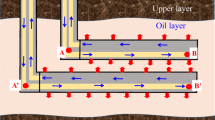The paper is devoted to the development of models and methods to describe and predict the process of steam-assisted gravity drainage during the extraction of high-viscosity oil. On the basis of the original physicomathematical model, the authors have considered the problems of circulation of a steam in the injection well for preheating the stratum, the stratum sweep by the action of the steam, and methods to increase it. The presence of the optimum spacing between pairs of reactive wells or the optimum density of the network of wells has been established. From an analysis of basic mechanisms of the process, the authors have identified the causes of the maximum value of the oil recovery factor for the optimum network of wells. The possibility has been shown of raising the economic efficiency of the process of passage from the injection of a steam to the injection of unheated water in the final stage of the process.
Similar content being viewed by others
References
Sh. K. Gimatudinov, The Physics of an Oil and Gas Stratum [in Russian], 2nd revised and enlarged edition., Nedra, Moscow (1971).
S. M. Farouq Ali, Life after SAGD — 20 years later, Conf. Paper SPE-180394-MS from SPE Western Regional Meeting, 23−26 May 2016. Anchorage, Alaska, USA (2016).
R. M. Butler, G. S. McNab, and H. Y. Lo, Theoretical studies on the gravity drainage of heavy oil during in situ steam heating, Can. J. Chem. Eng., 59, No. 4, 455–460 (1981).
S. Akin, Mathematical modeling of steam-assisted gravity drainage, Comput. Geosci., 32, 240–246 (2006).
P. E. Morozov, Analytical model of the process of steam-assisted gravity drainage in an anisotropic bed, J. Eng. Phys. Thermophys., 92, No. 3, 723–728 (2019).
M. Kh. Khairullin, P. E. Morozov, M. N. Shamsiev, and A. I. Abdullin, Estimation of the discharge of a horizontal well in the process of mining a superviscous-oil pool by the method of steam-assisted gravity drainage, J. Eng. Phys. Thermophys., 87, No. 4, 893–899 (2014).
N. Heidari, S. H. Hejazi, and S. M. Farouq Ali, Steam-assisted gravity-drainage performance with temperature-dependent properties — A semianalytical approach, SPE J., 22, No. 3, 902–911 (2017).
Z. Zargar and S. M. Farouq Ali, Analytical treatment of steam-assisted gravity drainage: Old and new, SPE J., 23, No. 1, 117–127 (2018).
C. Wang and J. Y. Leung, Characterizing the effects of lean zones and shale distribution in steam-assisted-gravity-drainage recovery performance, SPE Reserv. Eval. Eng., 18, No. 3, 329–345 (2015).
N. Edmunds and J. Peterson, A unified model for prediction of CSOR in steam-based bitumen recovery, Paper No. 2007-027 from Canadian International Petroleum Conference, 12−14 June 2007, Calgary, Alberta, Canada (2007).
Y. Yang, S. Huang, Y. Liu, Q. Song, S. Wei, and H. Xiong, A multistage theoretical model to characterize the liquid level during steam-assisted-gravity-drainage process, SPE J., 22, No. 1, 327–338 (2017).
M. Irani, On subcool control in steam-assisted-gravity-drainage producers — Part I: Stability envelopes, SPE J., 23, No. 3, 841–867 (2018).
K. M. Fedorov, A. Ya. Gil′manov, and A. P. Shevelev, Comparative analysis of various patterns of arrangement of wells for the steam-assisted gravity drainage technology, Conf. Paper SPE-191494-18RPTC-RU from the SPE Russian Oil and Gas Technical Conference, 15−17 October 2018, Moscow (2018).
K. H. Chung and R. M. Butler, Geometrical effect of steam injection on the formation of emulsions in the steam-assisted gravity drainage, J. Can. Pet. Technol., 01, No. 2, 36–42 (1988).
É. B. Chekalyuk, Thermodynamics of an Oil Stratum [in Russian], Nedra, Moscow (1965).
M. Keshavarz, T. G. Harding, and Z. J. Chen, Modification of Butler’s unsteady-state SAGD theory to include vertical growth of steam chamber, Conf. Paper SPE-180733-MS from Society of Petroleum Engineers SPE Canada Heavy Oil Technical Conference, 7−9 June 2016, Calgary, Alberta, Canada (2016).
Author information
Authors and Affiliations
Corresponding author
Additional information
Translated from Inzhenerno-Fizicheskii Zhurnal, Vol. 94, No. 3, pp. 611–620, May–June, 2021.
Rights and permissions
About this article
Cite this article
Gil′manov, A.Y., Fedorov, K.M. & Shevelev, A.P. Mathematical Modeling of the Process of Steam-Assisted Gravity Drainage during the Extraction of High-Viscosity Oil. J Eng Phys Thermophy 94, 592–601 (2021). https://doi.org/10.1007/s10891-021-02333-6
Received:
Published:
Issue Date:
DOI: https://doi.org/10.1007/s10891-021-02333-6



